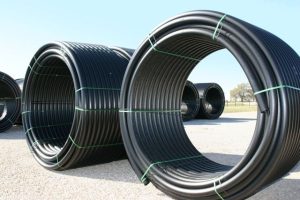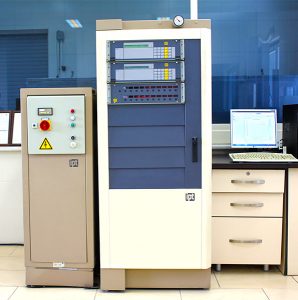
Polyethylene pipe production experiments in Iran
Introduction
Polyethylene pipes are one of the most widely used materials in industries such as water supply, sewage, gas distribution, and many others. Due to their physical and chemical properties, such as corrosion resistance, long lifespan, and low maintenance costs, these pipes are used in various projects. Given the importance of these pipes, their quality must be accurately evaluated at all stages of production. To ensure the quality and performance of polyethylene pipes, a series of tests are conducted on both raw materials and the final product. This article discusses the most important standard tests performed in the production of polyethylene pipes based on global criteria and internationally recognized standards.
Polyethylene pipe production experiments in Iran

1. Melt Flow Index (ISO 1133)
The Melt Flow Index (MFI) is an important test to measure the melt flow rate of polyethylene under specific temperature and time conditions. This test helps manufacturers predict the behavior of raw materials in the extrusion process. For this test, the molten polyethylene passes through a specific filter, and the amount of material passing through in a set period is measured. This test is critical for establishing production process parameters and ensuring uniformity in materials during the manufacturing stages. The difference in MFI between the raw material and the final product should not exceed 2%.
2. Density Determination (ISO 1183)
The density of polyethylene plays a crucial role in the physical properties of the pipes produced. This test is performed to measure the density of both the raw materials and the finished pipes using a flotation method. In this process, the pipes are immersed in a fluid with a known density, and the density changes are measured. The results of this test indicate the level of material compactness and the quality of the production process. A higher density is typically associated with better quality and greater strength.
Polyethylene pipe production experiments in Iran
3. Carbon Content Determination (ASTM D 1603)
The carbon content test is one of the most important tests for evaluating the quality of polyethylene raw materials. In this test, a sample of the raw material is placed in a furnace at 800°C under the influence of nitrogen gas for pyrolysis. Then, the remaining carbon is burned with oxygen to determine the amount of ash (additives) in the sample. According to the standards, the permissible carbon content in polyethylene pipes should be between 2% and 2.5% by weight, and the carbon must be uniformly distributed throughout the pipe.
4. Tensile Test (BS2782-EN63-ASTM D 2412)
The tensile test is used to assess the mechanical properties of polyethylene pipes under external pressure. In this test, the pipes are subjected to a three-point loading test, and properties such as maximum strength, elongation at break, elastic modulus, and stress-strain behavior are measured. These results are crucial for evaluating how the pipe will perform under different loading and stress conditions. This test is particularly important for projects where pipes are exposed to high external forces or stresses.
Polyethylene pipe production experiments in Iran
5. Hydrostatic Pressure Test (EN 921)
The hydrostatic pressure test is performed to evaluate the strength of the pipes against internal pressures. In this test, the pipes are immersed in water and subjected to a constant internal pressure for various durations at different temperatures. The test durations depend on the temperature and type of raw material used. Long-term tests (up to 1000 hours at 80°C) help assess the effect of hydrostatic pressures on the pipes. Any defects such as cracking, bulging, or leakage during this test indicate that the pipe has failed.
6. Burst Pressure Test (ASTM D 1599)
The burst pressure test is designed to assess the pipe’s resistance to increasing internal pressure. In this test, pipes are subjected to a rising internal pressure until they fail within a specific time frame (usually 60 to 70 seconds). The goal is to evaluate the pipe’s ability to withstand critical pressure conditions. Pipes that burst without any prior swelling or longitudinal cracking are deemed unfit for use.
7. Heat Reversion Test (ISO 2505)
The heat reversion test assesses the dimensional changes of pipes when exposed to high temperatures. Pipes are placed in a circulating air oven at 110°C for a period of one to three hours, depending on their wall thickness, and then allowed to cool. After cooling, the pipes should show no more than 3% length change from their original state. This test is particularly important for pipes that will be exposed to high-temperature environments during operation.
Polyethylene pipe production experiments in Iran
8. Dimensional Measurement and Appearance Inspection (ISO 11922)
This test is performed to check the dimensions and surface quality of polyethylene pipes. The pipes must be free of any significant defects or internal irregularities. Minor dents or surface imperfections are acceptable as long as they do not reduce the pipe’s wall thickness below the minimum allowed. This test ensures that the pipes comply with the required dimensional standards and have a smooth, defect-free surface.
Polyethylene pipe production experiments in Iran

9. Oxidative Induction Time Test (O.I.T)
The O.I.T test is used to assess the thermal stability of the raw materials. This test shows how long the material can resist oxidation at high temperatures. For polyethylene, the degradation time should not be less than 20 minutes, according to the standards. This test is essential for polyethylene pipes that will be exposed to high-temperature conditions during their service life.
10. Compression Test (ISO-4437 and EN-12106)
The compression test evaluates the durability of the pipes under environmental pressures and temperature changes. In this test, the pipes are subjected to pressure for a specified period and should maintain their structural integrity without any defects or dimensional changes. The pipes are then subjected to an 8-bar pressure at 80°C for 1000 hours. The pipe must pass this test without any significant deterioration.
Conclusion
Various tests on polyethylene pipes play a crucial role in ensuring the quality and performance of these products. These tests not only help manufacturers evaluate both raw materials and final products, but they also ensure that the pipes will perform reliably in different environmental and operational conditions. By adhering to international standards and conducting regular tests, manufacturers can guarantee the high quality of polyethylene pipes, ensuring their effective use in various industrial projects.
The heat reversion test assesses the dimensional changes of pipes when exposed to high temperatures. Pipes are placed in a circulating air oven at 110°C for a period of one to three hours, depending on their wall thickness, and then allowed to cool. After cooling, the pipes should show no more than 3% length change from their original state. This test is particularly important for pipes that will be exposed to high-temperature environments during operation.